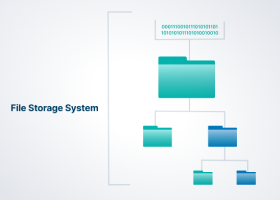Cloud File Services
Let’s jump in and learn:
What Is Cloud File Service?
At the basic level, cloud file services provide a file system-based architecture that allows the storage of any kind of information, including structured, unstructured, and semi-structured data. Enterprise cloud file services are distinct from the file-sync-share services that focus on individual users.
Consumer-oriented sync-and-share services do not offer enterprise cloud offerings’ management and monitoring functions. In addition, consumer-focused services typically work by synchronizing files on a user’s desktop or another personal device. Cloud file service, focused on enterprise-scale organizations, provides a solution that bridges that gap by offering end-user convenience and enterprise-level control and management capabilities.

Cloud file services are a globally distributed file system created to give distributed users access to their files from anywhere and to replace traditional network-attached storage (NAS) environments. NAS stores data on networked appliances which contain one or more hard drives, often arranged into logical, redundant storage containers, or RAID, with local area network (LAN) access via a standard Ethernet connection.
Cloud file services offer access to file data from a hosted cloud storage infrastructure connected via the internet. This allows the cloud file service to work the same way as an on-premises NAS, but with more flexibility for remote access using a browser.
What Are the 4 Types of Cloud Storage?
Cloud storage is one of the most important types of cloud file services. It is defined as a data deposit model in which digital files are stored on virtual or cloud servers hosted by third parties. There are four types of cloud storage—private, public, hybrid, and community.
Private cloud storage
Private cloud storage is also known as enterprise or internal cloud storage. Data is stored on the company or organization’s systems, accessed with an intranet or virtual private network (VPN), and protected by the organization’s firewall.
Public cloud storage
The most popular cloud storage solution, public cloud storage is hosted by solution providers and used by organizations that want to utilize third-party’s computer resources. This includes hardware and software, along with support services.
Hybrid cloud storage
Combining private and public cloud storage, hybrid cloud storage offers the best of both worlds to organizations—the security of a private cloud and the personalization of a public cloud. Hybrid cloud storage allows data to be stored on the private cloud, with information processing tasks handled on the public cloud.
Community cloud storage
Community cloud storage is a type of private cloud storage model. It offers cloud solutions for specific types of businesses or communities (e.g., health, financial, legal, and education sectors). With community cloud storage, architectures, compute capabilities, software, and development tools are curated to meet the community’s unique requirements.
Access Files from Multiple Devices
There are many cloud file services that provide access to files remotely from multiple devices. These services come with a variety of advanced functionality, such as file encryption and file sharing, but the foundation is the ability to access files or perform a file transfer from anywhere in the world. The following are three ways to access files from multiple devices:
1. Cloud storage
2. Network-attached storage (NAS)
3. Remote access software
Protect Your Organization’s Data
Whether your company utilizes a cloud file services or wherever your data resides and is used, the following data protection approaches should be considered to ensure the integrity and safety of sensitive information.
- Audit files and implement content control protocols
- Classify data with appropriate controls for each level
- Enforce strong data storage security policies
- Implement data protection tools (e.g., anti-malware, anti-ransomware, data loss prevention)
- Install patches
- Integrate data encryption
- Keep operating systems up to date
- Monitor connected applications, devices, and accounts
- Require employee security awareness training
- Require multi-factor authentication (MFA)
- Secure accounts with strong passwords
- Turn on account alerts
- Use secure connections
Recover Lost Files
Mistakes happen, and files accidentally get deleted. The good news is that, in many cases, the files are simply “misplaced” and not lost forever. Even if files are deleted deliberately, it is often possible to recover a past draft or version of a file. The following are four of the most common methods to recover lost files.
1. How to recover deleted data from cloud file services using file history
Most cloud file services solutions maintain backups of file history. A search for the file name will likely turn up the deleted file. From here, there is usually an option to restore the missing file or folder from a saved version. Once this is found, select the version to recover and restore the data.
2. How to recover deleted files from the Recycle Bin
Search the Recycle Bin for the missing file or folder by double-clicking on the Recycle Bin or trashcan to see what is in there. When the item has been located, it can be dragged back to the working folder. Depending on how settings were implemented, files are generally saved for 30 days after being deleted.
3. How to recover deleted files using the Control Panel
If a deleted file cannot be found in the Recycle Bin or trash can, a copy could still be stored somewhere else. A search from the Control Panel can help find it in an unexpected location.
4. Use data recovery or snapshot recovery software
Data recovery software is designed to facilitate the recovery of corrupted, deleted, or inaccessible data from a device. For specialized situations- such as recovery from a potential ransomware attack- snapshot recovery solutions are becoming more popular.
Get the Right Amount of Storage Your Organization Needs
Having too much storage is usually more commonplace than having too little, since it is relatively easy to add storage as it is needed. The best way to determine how much cloud storage is required is to assess what needs to be stored, its source, and how it is generated. It is essential to understand how new data will be developed as this will provide details about the frequency and volume and enable an accurate forecast of needs.
It is also important to determine the options for scaling storage up, which is usually the case, or down if the company’s needs change. These choices, coupled with the degree of confidence that the estimates for required storage capacity are accurate, should help with selection of the right plan, which could be a monthly, annual, or multi-year subscription plan.
The Adoption of Cloud File Services Continues to Accelerate
The widespread and voluminous move to remote work has solidified cloud file services as a crucial part of all organizations’ operations toolkits. However, this move was already in process as organizations sought to move from capital expenditures (CapEx) operating expenses (OpEx). The robust feature sets and ease of use available with many cloud file services have facilitated this transition and continue to accelerate its expansion.
Egnyte has experts ready to answer your questions. For more than a decade, Egnyte has helped more than 16,000 customers with millions of customers worldwide.
Last Updated: 26th March, 2023



